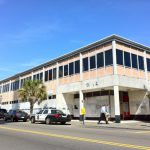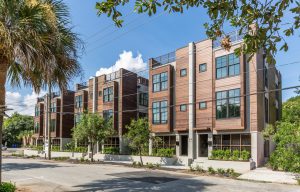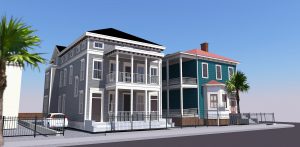Master Preservationist Program-Day Seven. Asphalt & Infill. Just how smart are we?
How many suburban strip malls and parking expanses do you see abandoned and lifeless on a daily basis? Tons. How many ex-urban neighborhoods are now struggling to stay afloat? Many. We are all fatter, we drive more, and we know our neighbors less. Yada yada yada – I know you’ve heard it all. But it’s time to admit that the post-WWII model for American development has been unsustainable at its core. It’s time to put a lid on our asphalt explosions and figure out how to make lemonade out of those lemons. No, we don’t have to sacrifice the American Dream of a big house with a yard and two cars in the driveway – we just have to get a little bit smarter about planning for it.
On day seven of the Master Preservationist Pilot Program – we addressed smart growth, land use and sustainable planning. I’ve been passionate about this topic since I first read Jane Jacob’s masterpiece, The Death and Life of Great American Cities, more than a decade ago. Having lived in all types of areas – rural, suburban, hamlet, urban and more – Jacobs’ concepts rang true to my experience in each and kicked off my consideration of what city and neighborhood characteristics influence quality of life.
Anyway, enough about me.
Our class reading for this topic outlines concepts very much aligned with Jacobs’. The Smart Growth Manual, a follow up to Suburban Nation, is considered to be today’s Death and Life. Whether you agree with everything they say or not, it’s worth a browse.
Josh Martin, former director of land use at the Coastal Conservation League, led our class on a lively discussion of planning- what can go right and what can go horribly wrong and why, and then took us on a tour of the Cannonborough/Elliotborough neighborhood.
Cannonborough/Elliotborough is a prime example of smart growth. Sure – there’s still a way to go and the transformation of both Spring and Cannon streets from fast one-way thoroughfares to slower two-way neighborhood streets has been delayed by the upcoming construction on the Crosstown – but regardless, the neighborhood is a model to follow.
Why? Because it has implemented many of the principles of smart growth:
- Multiple street types – through streets, narrow streets, tiny alleys, one block long streets.
- Mixed-used developments – see the Midtown development for a great example of this. Retail below, housing above.
- Housing diversity – houses, cottages, condos, rentals, affordable housing.
- Visual interest – multiple rooflines, colors, old and new, shops at eye level right up at the sidewalk.
- Retail distribution – corner stores, restaurants, bakeries, flower shops, hair salons, law offices.
- Preservation – respect for historic structures and integrating the new with the old.
- Green spaces and community gardens – Simonton Park, Dereeff Ct, The Bogarden, and Elliotborough Park, (for photos of these last two, check out my Lowcountry Local Urban Garden tour photo set)
- Urban infill – more infill projects than I ever knew of….
Urban infill focuses on the reuse and repositioning of obsolete or underutilized buildings and sites. This type of development is essential to renewing blighted neighborhoods and knitting them back together with more prosperous communities.
So walk with me on a photo tour of some of the great projects that have already been completed or are underway in this lively part of the Charleston Peninsula.
Tully Alley and Charles St – these two little intermingled streets are one of Charleston’s secret treasures – as there are traditional, fanciful and medieval elements that make up this community. I’ve photographed this many times before, but each time I go in here I see or learn something new. (Like that there’s an enclosed rooftop pool!) The architects and developers of this gem are New World Byzantine, who by the way are immediately being added to my favorite Charleston architects list. I’ve lusted after their work for years but never knew it was them.
Morris Square – designed by Vince Graham, developer of the award-winning I’On. This project combines retail and diverse housing styles with a central park owned by the City.
Sires Lane
Peecksen Ct – built in 2008, Peecksen Court properties are available to qualified buyers under the City of Charleston Homeownership Initiative Program.
266 Ashley Development – little did I know there was an inspired project behind this cute renovated cottage I always look at when I am sitting at the stoplight at Ashley Avenue and the Crosstown.

266 Ashley Ave
The architects and developers of this are the same as Tully Alley and Charles St – New World Byzantine. I am VERY excited about this one. By the way, the homes here use geothermal heating & cooling.
Humphrey Ct – again integrating historic with new construction, this a road I had never been on yet which I pass frequently. It forms an “L” shape with Porters Ct.
Porters Ct
And here’s a map for your reference.
View Urban Infill in a larger map
So what do you think? Would you agree with my assessment that Cannonborough/Elliotborough is doing a pretty good job in intelligently directing its growth? Right now, the hot topic there is whether or not to allow rezoning for hotels.
For more on today and this neighborhood, check out these links below….
More photos from the day on Picasa
Read It’s a Miracle in Midtown
Read The Spring/Cannon Corridor is Rising
Read Master Preservationist Program-Day Six.
And just for a little treat – I’ll leave you with a lovely photo of a private home we were lucky enough to enjoy….
Related articles
- How much urbanism is enough? (switchboard.nrdc.org)









 Previous Post
Previous Post






[…] Read Master Preservationist Program – Day Seven. […]
[…] about it after my first visit during the Master Preservationist Program in March in a post called Asphalt & Infill, Just how smart are we? At that time only part of it had been built with the help of builder David House. Today two […]
[…] Day Seven. Asphalt and Infill. Just how Smart are We? […]